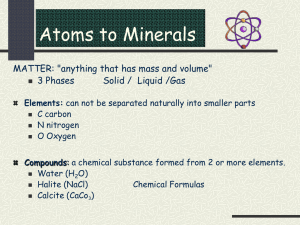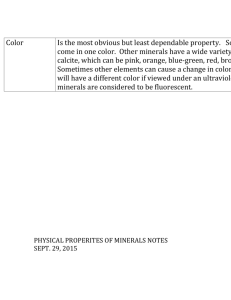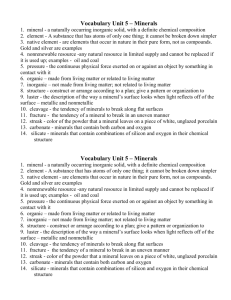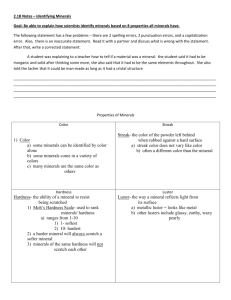Mineral Reading Handout Using Resources Geologists study
advertisement
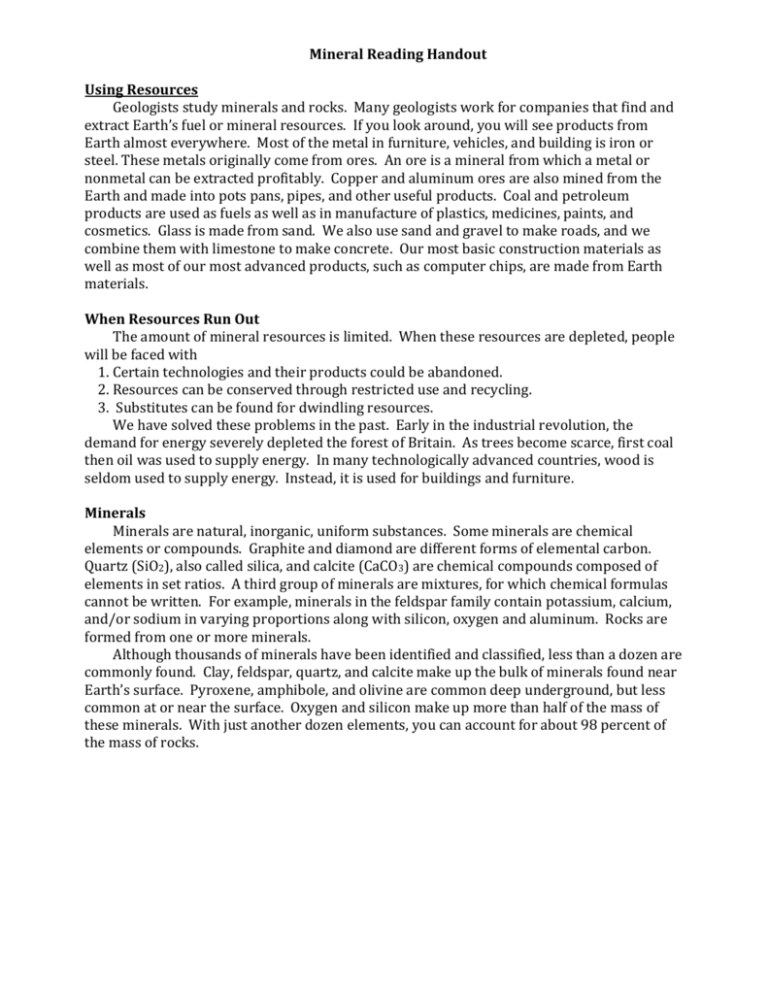
Mineral Reading Handout Using Resources Geologists study minerals and rocks. Many geologists work for companies that find and extract Earth’s fuel or mineral resources. If you look around, you will see products from Earth almost everywhere. Most of the metal in furniture, vehicles, and building is iron or steel. These metals originally come from ores. An ore is a mineral from which a metal or nonmetal can be extracted profitably. Copper and aluminum ores are also mined from the Earth and made into pots pans, pipes, and other useful products. Coal and petroleum products are used as fuels as well as in manufacture of plastics, medicines, paints, and cosmetics. Glass is made from sand. We also use sand and gravel to make roads, and we combine them with limestone to make concrete. Our most basic construction materials as well as most of our most advanced products, such as computer chips, are made from Earth materials. When Resources Run Out The amount of mineral resources is limited. When these resources are depleted, people will be faced with 1. Certain technologies and their products could be abandoned. 2. Resources can be conserved through restricted use and recycling. 3. Substitutes can be found for dwindling resources. We have solved these problems in the past. Early in the industrial revolution, the demand for energy severely depleted the forest of Britain. As trees become scarce, first coal then oil was used to supply energy. In many technologically advanced countries, wood is seldom used to supply energy. Instead, it is used for buildings and furniture. Minerals Minerals are natural, inorganic, uniform substances. Some minerals are chemical elements or compounds. Graphite and diamond are different forms of elemental carbon. Quartz (SiO2), also called silica, and calcite (CaCO3) are chemical compounds composed of elements in set ratios. A third group of minerals are mixtures, for which chemical formulas cannot be written. For example, minerals in the feldspar family contain potassium, calcium, and/or sodium in varying proportions along with silicon, oxygen and aluminum. Rocks are formed from one or more minerals. Although thousands of minerals have been identified and classified, less than a dozen are commonly found. Clay, feldspar, quartz, and calcite make up the bulk of minerals found near Earth’s surface. Pyroxene, amphibole, and olivine are common deep underground, but less common at or near the surface. Oxygen and silicon make up more than half of the mass of these minerals. With just another dozen elements, you can account for about 98 percent of the mass of rocks. Identifying Minerals Geologists usually identify minerals on the basis of their physical and chemical properties. For the rare or uncommon minerals, geologists use charts, or a more comprehensive information contained in a mineralogy resource. Color Many minerals have a characteristic color. Pyrite (fools gold) is usually a brassy yellow color. Amandine garnet is valued for its deep red color. But certain colorless or white minerals are often discolored by impurities. Quartz and calcite are usually colorless, although they may be found in almost any color, depending on the impurities they contain. Dark-colored minerals such as the amphibole and pyroxene families are easier to identify because impurities are unlikely to cause color variations. Luster Luster describes the way light is reflected from the freshly cut surface of a mineral. Minerals with metallic luster have a hard, shiny look, like polished metal. This is because light is unable to penetrate the surface and almost all the light is reflected. Minerals with nonmetallic luster can also be shiny, but nonmetallic luster differs from a metallic luster because some of the light is transmitted into and through the mineral while some is reflected. Nonmetallic luster include glassy, waxy, pearly, and earthy, which is dull. Streak Rubbing a fresh corner of the minerals across a white unglazed streak plate performs the test for streak. The streak is the powdered form of the mineral. Some metallic minerals leave behind a powder that is not the same color as the mineral. Crystal Structure A crystal is a regularly shaped solid formed by an ordered pattern of atoms. Minerals form characteristically shaped crystals. Calcite and quartz can look very similar. Both are fairly common and are often white or colorless with a glassy luster. However, their crystals are very different. Quartz crystals are hexagonal (six-sided) in cross section, while crystals of calcite from rhombohedra solids. (A rhombohedra solid resembles a rectangular solid that has been pushed over to one side so that all the faces have parallel edges, but none meet at right angles) Pyrite and galena form cubic crystals. The crystals of mica grow in “books” of thin flexible sheets. Many minerals form distinctive and beautiful crystals. For that reason, crystals are called the “flowers” of the mineral world. Hardness Calcite and quartz also differ in hardness. You test for hardness by scratching the unknown mineral with the edge or point of other minerals of known hardness. Quartz is able to scratch most other minerals. Because calcite is softer than quartz, calcite cannot scratch quartz, but quartz can scratch calcite. The geologist Friedrich Mohs, created a scale of hardness that uses relatively common minerals. On the Moh’s scale talc is the softest mineral. The hardness of talc is 1. The hardest natural substance is diamond. Its hardness is 10. The hardness of a fingernail is 2.5, calcite is 3, window glass is 5.5 and quartz has a hardness of 7. Cleavage If a mineral breaks readily along flat surfaces it shows cleavage. Cleavage comes from a Latin word meaning to cut, or cleave. Many minerals break along flat surface called cleavage planes. These cleavage planes are sometimes but not always parallel to the sides of crystals. For example, halite (rock salt) breaks into small cubes and rectangular solids the same shape as it’s crystals. However, quartz, which forms hexagonal crystals with flat faces, does not break along parallel planes. Quartz breaks along curved surfaces: a property known as concoidal fracture. Density Minerals also vary in density and specific gravity. Specific gravity is a ratio of the density of a substance to the density of water. Water’s density is 1 g/cm 3. Therefore, a mineral with a density of 4 g/cm3 has a specific gravity of 4. Gold is the densest substance you commonly see, it has a density of about 10 g/cm3, and the density of lead is about 12 g/cm3. You can determine density in two ways: dividing the mass of a sample by its volume or by floatation. A substance will sink in a liquid that is less dense than it is and float in a liquid that is denser than it is.


